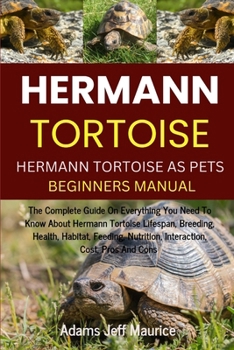Hermann Tortoise: The Complete Guide On Everything You Need To Know About Hermann Tortoise Lifespan, Breeding, Health, Habitat, Feeding,
The family Testudinidae includes small to medium-sized tortoises, such as the Hermann tortoise (Testudo hermanni). They are indigenous to southern Europe, especially the Balkan Peninsula and the Mediterranean countries of France, Spain, and Italy. Because of their unusual looks and kind personalities, these tortoises are beloved and well-known among reptile lovers, who often keep them as pets. Physical attributes: - The domed carapace (shell) of Hermann tortoises ranges in hue from yellowish-brown to dark brown. On their shells, some people could also have black patterns or markings. - Compared to other tortoise species, they are quite small, with adult lengths of 6 to 8 inches (15 to 20 cm). - With five claws on each foot for climbing and digging, their limbs are strong and designed for movement on land. Conduct and Way of Life: - Hermann tortoises are mostly terrestrial in their natural habitat, with a preference for rocky, arid places with an abundance of vegetation. They are known to be diurnally active during the day, spending much of their time searching for plants and sometimes fruits. - These tortoises live alone most of the time, but they might socialize with other animals in the breeding season or when they share food or basking areas. - Hermann tortoises have adapted well to the Mediterranean climate, which can be hot and dry in the summer and mild and moist in the winter, thanks to their slow metabolism and capacity to endure extended periods of time without food or drink. Origin and History Dating back thousands of years, Hermann tortoises have a fascinating history entwined with human civilization. - Ancient Cultural Significance: Held in high regard in the Greek and Roman cultures, they were frequently portrayed as representations of endurance, knowledge, and perseverance in literature and art. - Human Interaction: In the past, these tortoises were hunted for their beautiful shells and occasionally for food, which caused population decreases in some areas. - Conservation Status: As a result of habitat degradation, collecting for the pet trade, and other human activities that negatively impact their numbers, Hermann tortoises are currently protected by a number of international accords and conservation legislation. Organization and Subspecies: - The Eastern Hermann tortoise (Testudo hermanni boettgeri) and the Western Hermann tortoise (Testudo hermanni hermanni) are the two primary subspecies of Hermann tortoises. Each subspecies differs somewhat in color and pattern of shell, as well as in its specific geographic range. An appreciation of Hermann tortoises as pets and knowledge of their requirements for care in captivity can be gained by having a thorough awareness of their history, behavior, and general overview.
Format:Paperback
Language:English
ISBN13:9798332008979
Release Date:July 2024
Publisher:Independently Published
Length:134 Pages
Weight:0.42 lbs.
Dimensions:0.3" x 6.0" x 9.0"
Customer Reviews
0 rating





